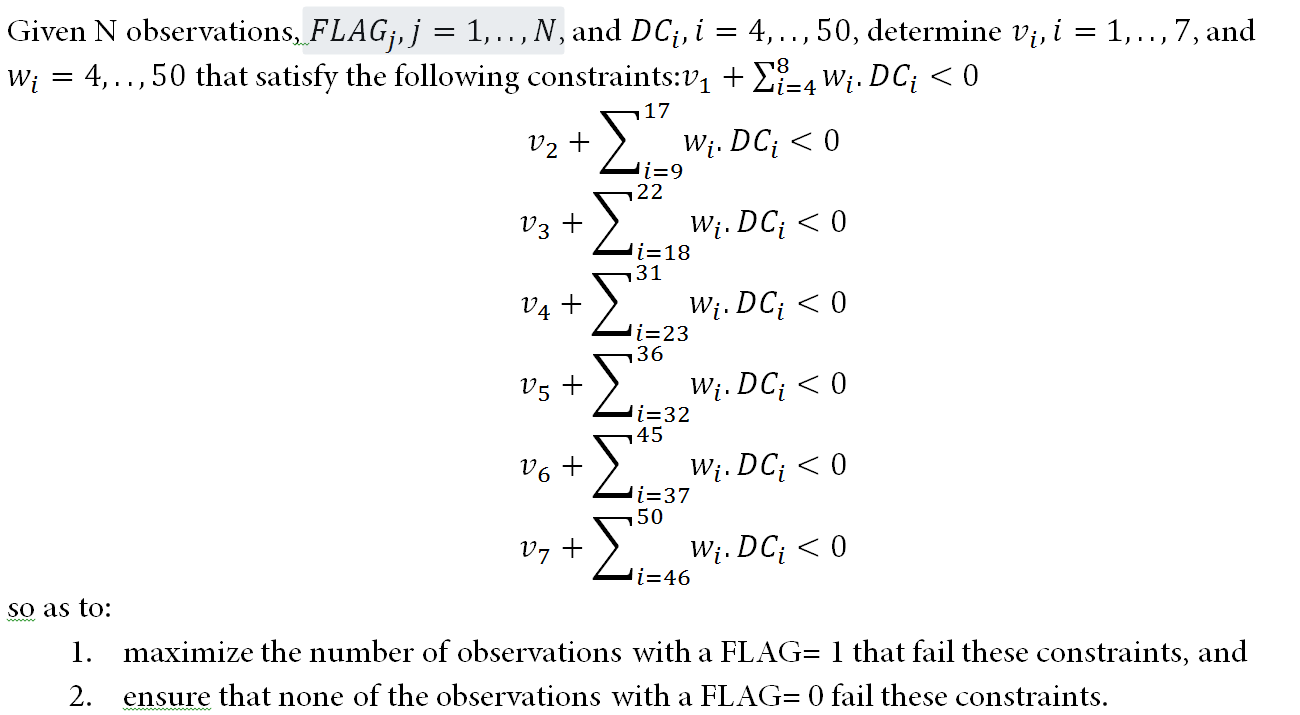- RSS Feed
- Mark Topic as New
- Mark Topic as Read
- Float this Topic for Current User
- Bookmark
- Subscribe
- Mute
- Printer Friendly Page
- Mark as New
- Bookmark
- Subscribe
- Mute
- RSS Feed
- Permalink
- Report Inappropriate Content
Hello -
I am trying to solve the following problem:

I need help identifying the proper procedure and structuring the statements.
Your help is apprecated.
Siva
- Mark as New
- Bookmark
- Subscribe
- Mute
- RSS Feed
- Permalink
- Report Inappropriate Content
You can use PROC OPTMODEL in SAS/OR to formulate the problem and call either the MILP solver or possibly the CLP solver:
SAS/OR(R) 13.2 User's Guide: Mathematical Programming
Besides the v and w decision variables, you need a binary decision variable x[j,k] that indicates whether observation j fails constraint k. You want to fix x[j,k] = 0 for all observations j with FLAG = 0 and all constraints k. If you are using the MILP solver, you can enforce this relationship by introducing big-M constraints (assuming DC also depends on j):
/* if x[j,k] = 1 then v
-v
/* if x[j,k] = 0 then v
v
where M1[j,k] and M2[j,k] are upper bounds on the left hand sides, and epsilon is a small positive number, say 1e-6, that represents how far away from 0 you consider "negative" to be.
If you are using the CLP solver, you can enforce the relationship with a single set of REIFY constraints, without big-M or epsilon:
REIFY(x[j,k], v
But note that the CLP solver requires all variables to be integer, and I don't know whether your v and w have that restriction.
There is a bit of ambiguity in the problem statement. Does "fail these constraints" mean fail all constraints or fail at least one constraint?
In either case, you need another binary variable y
- Mark as New
- Bookmark
- Subscribe
- Mute
- RSS Feed
- Permalink
- Report Inappropriate Content
RobPratt ..
Thank you for the detailed reply. That was really helpful.
Regarding the questions in your post..
1. "But note that the CLP solver requires all variables to be integer, and I don't know whether your v and w have that restriction."
In my problem, v and w are real numbers
2. "There is a bit of ambiguity in the problem statement. Does "fail these constraints" mean fail all constraints or fail at least one constraint?"
You have it right. "Fail these constraints" means "Fail at least one constraint".
Thanks for your help.
Siva
- Mark as New
- Bookmark
- Subscribe
- Mute
- RSS Feed
- Permalink
- Report Inappropriate Content
Glad to help. Please mark this question as Answered.
April 27 – 30 | Gaylord Texan | Grapevine, Texas
Registration is open
Walk in ready to learn. Walk out ready to deliver. This is the data and AI conference you can't afford to miss.
Register now and lock in 2025 pricing—just $495!
- Marketing Minutes | Insights in 20: Streamlining Your Data Into One Consistent View | 14-Jan-2026
- Ask the Expert: Real-Time Agent Assist and Next-Gen Strategy for Financial Services | 15-Jan-2026
- Discovery-based Investigation in SAS Visual Investigator – Your Guide to Better Searches | 20-Jan-2026
- Ask the Expert: The AI Advantage: How SAS Customer Intelligence 360 Solves Real Marketing Challenges | 27-Jan-2026
- DCSUG presents SAS OnDemand for Academics: the Easy Way to Learn SAS For Free for Students, Educator | 27-Jan-2026
- SAS Innovate 2026 | Grapevine, Texas | 27-Apr-2026

